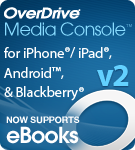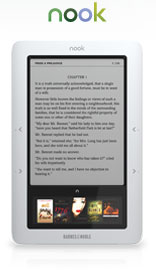 I just received an update from eReaderIQ. This is a service that lets you know when there are new free books added to the Kindle store. It will also tell you about price drops, and recent Kindlization of previously non Kindle titles, as well as an advance search feature for the Kindle store. I don’t have a Kindle, and I don’t even like Amazon all that much, but I love this service.
I just received an update from eReaderIQ. This is a service that lets you know when there are new free books added to the Kindle store. It will also tell you about price drops, and recent Kindlization of previously non Kindle titles, as well as an advance search feature for the Kindle store. I don’t have a Kindle, and I don’t even like Amazon all that much, but I love this service.
 When I was purchasing “dead tree” books, I got them from Barnes & Noble. Strictly speaking, I usually got them from www.bn.com, but that’s still not Amazon. They had a real store I could visit when I wanted truly instant gratification, and, when I only needed moderately quick gratification, B&N shipped faster without my having to pay extra for Prime Membership.
When I was purchasing “dead tree” books, I got them from Barnes & Noble. Strictly speaking, I usually got them from www.bn.com, but that’s still not Amazon. They had a real store I could visit when I wanted truly instant gratification, and, when I only needed moderately quick gratification, B&N shipped faster without my having to pay extra for Prime Membership.
When I bought an ebook reader, I bought a Nook. One of the big selling points was that it had some built-in flexibility. I could use it for ebooks from the library, if I was willing to jump through some hoops (that process was fairly teeth-grinding the first time). I could also get free books from Baen and Project Gutenberg, while still having the advantage of being able to shop for books in bed at midnight if I really didn’t feel like reading anything I had on hand. (The local Barnes and Noble currently hands out a cheat-sheet with every Nook they sell that gives new Nook owners the handy-dandy instructions on how to borrow ebooks from the library and read them on their new Nook. This is a win-win that Amazon just can’t match.)
But now I have an iPad, and it changes things. An iPad is essentially vendor agnostic. As long as “there’s an app for that”, it can be anything I want it to be. Or, everything I want it to be. It’s a Nook and an Overdrive Media Console and a Bluefire Reader and, occasionally, a Kindle.
eReaderIQ tells me when there is a new ebook available for free in the Kindle store. Even if I absolutely hate the title, I absolutely love getting the information. And, unfortunately for the state of my various TBR lists and piles, sometimes I find the title interesting enough to download. I know this is a loss-leader for Amazon. They hope that people will get the freebie and then buy other books by the same author. If I want something that’s not free, I’ll either check the library, or, purchase from B&N, so it’s not working on me, but the concept is excellent. And, it absolutely proves the point made by librarians that letting people read the actual work is what turns people on to getting more books, including buying more books! The freebie is a teaser, and I’d be willing to bet that both Amazon and the authors who put their books up think it works for them in the long run.
 Baen Books has a terrific explanation of this from their perspective, written by Eric Flint, who has also put his money where his mouth is as an author. The Baen Free Library makes the first couple/three books in many of their most popular authors’ series (including Flint’s) available for free download. They know that if a reader likes the first two or three books, they will feel compelled to read the rest of the series. Think of it as a gateway drug.
Baen Books has a terrific explanation of this from their perspective, written by Eric Flint, who has also put his money where his mouth is as an author. The Baen Free Library makes the first couple/three books in many of their most popular authors’ series (including Flint’s) available for free download. They know that if a reader likes the first two or three books, they will feel compelled to read the rest of the series. Think of it as a gateway drug.
![]() But it’s the service aspect of this that I keep thinking about. As a service, this is absolutely fantastic. Barnes and Noble does not seem to have anything to match it, or if they do, they are hiding it quite thoroughly. Project Gutenberg even manages to do this, and they won’t make a profit on it, but Barnes & Noble can’t seem to manage it (neither can Google). What’s up with that?
But it’s the service aspect of this that I keep thinking about. As a service, this is absolutely fantastic. Barnes and Noble does not seem to have anything to match it, or if they do, they are hiding it quite thoroughly. Project Gutenberg even manages to do this, and they won’t make a profit on it, but Barnes & Noble can’t seem to manage it (neither can Google). What’s up with that?
Can libraries do the same thing? Just think about it for a second. Send out an email to patrons of what the library added, today. Just today. Every single day. And/or what the library placed on order today. And/or all the ebooks added to the library’s ebook site. There really isn’t any need to get fancy about this, eReaderIQ certainly doesn’t. It’s the books, and it’s all the books. There’s no added text, there’s no filtering, just the publisher blurb and the cover picture. If I don’t like the books, I can delete the email or ignore the twitterfeed. This could be automated, and it would provide a daily reminder of what the library does that’s good for readers. And it would be an automatic update to the library’s twitterfeed and Facebook page every day. Think of the possibilities!




